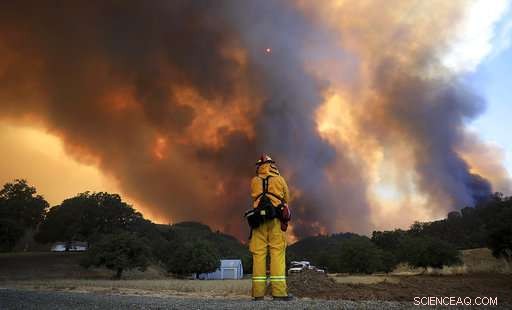
En este 2 de agosto, 2018, foto de archivo, una torre de humo sale de Cow Mountain como Burney, Calif., El bombero Bob May vigila la vegetación circundante para detectar incendios durante el incendio forestal del río cerca de Lakeport, Calif. Los incendios forestales que durante mucho tiempo han dado forma al paisaje del oeste de EE. UU. Se están volviendo más grandes y arden por más tiempo, trayendo más humo asfixiante, deslizamientos de tierra mortales y pérdida de hábitat. (Kent Porter / The Press Democrat vía AP, Expediente)
Los incendios forestales en los EE. UU. Han carbonizado a más de 10, 000 millas cuadradas en lo que va de año, un área más grande que el estado de Maryland, con grandes incendios todavía ardiendo en todos los estados occidentales, incluidos muchos que no están completamente contenidos.
Ya sea provocado por un rayo o por humanos, El fuego ha sido durante mucho tiempo una fuerza que ha dado forma al paisaje del oeste de EE. UU.
Caliente, los vientos secos pueden convertir las llamas en tormentas de fuego que dejan atrás tierras baldías carbonizadas propensas a la erosión y deslizamientos de tierra. Otros incendios limpian la maleza, abre el suelo del bosque a la luz del sol y estimula el crecimiento.
En las últimas décadas, las agencias gubernamentales dieron un vuelco de manera efectiva a ese ciclo de destrucción y renacimiento. Las políticas de extinción de incendios permitieron que los combustibles se acumularan en muchos bosques occidentales, haciéndolos más susceptibles a los grandes incendios.
Esas influencias se magnifican a medida que el desarrollo se adentra cada vez más en los bosques y el cambio climático trae consigo temperaturas más altas. Imágenes recientes de subdivisiones en llamas ponen el poder y el papel ecológico de los incendios forestales en el centro de atención.
Una mirada a los efectos ambientales de los incendios forestales:
HUMO Y RUINA
Más inmediatamente, el fuego trae destrucción.
Las temperaturas de los incendios extremos pueden superar los 2, 000 grados Fahrenheit:lo suficientemente caliente como para matar toda la vida vegetal, incinere las semillas escondidas debajo de la superficie y hornee el suelo hasta que se vuelva impermeable a la lluvia.
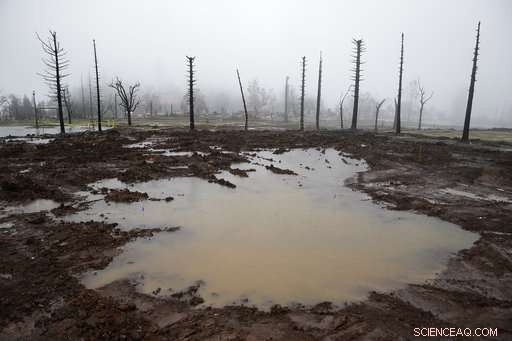
Este 8 de enero, 2018, La foto de archivo muestra piscinas de agua de lluvia estancadas donde una vez estuvo una casa en el vecindario de Fountaingrove en Santa Rosa, Calif. Los incendios forestales que durante mucho tiempo han dado forma al paisaje del oeste de EE. UU. Se están volviendo más grandes y arden por más tiempo, trayendo más humo asfixiante, deslizamientos de tierra mortales y pérdida de hábitat. Ya sea provocado por un rayo o por humanos, El fuego ha sido durante mucho tiempo una fuerza que ha dado forma al paisaje del oeste de EE. UU. (Foto AP / Eric Risberg, Expediente)
El paisaje sin vida se vuelve propenso a la erosión severa, ensuciando arroyos y ríos con sedimentos que matan a los peces y otras formas de vida acuática. Torrentes de escombros embarrados tras los incendios del año pasado en el sur de California mataron a 21 personas y destruyeron 129 viviendas.
Los científicos del Servicio Geológico de EE. UU. Dicen que el problema está empeorando a medida que aumenta el área quemada anualmente por incendios forestales. Un estudio del año pasado concluyó que los sedimentos de la erosión después de los incendios se duplicarían con creces para 2050 en aproximadamente un tercio de las cuencas hidrográficas occidentales.
El humo de los incendios forestales occidentales de este verano, un peligro potencial para la salud de las personas en riesgo, provocó el cierre del Parque Nacional Yosemite durante más de dos semanas y se trasladó a la costa este. según la NASA. Investigaciones recientes dicen que también impacta el cambio climático a medida que pequeñas partículas entran en espiral hacia la atmósfera superior e interfieren con los rayos del sol.
PREGUNTAS CLIMÁTICAS
Los científicos están ampliamente de acuerdo en que los incendios forestales están aumentando en América del Norte y otras partes del mundo a medida que el clima se calienta. Pero aún está emergiendo cómo ese cambio alterará la progresión natural del fuego y el recrecimiento.
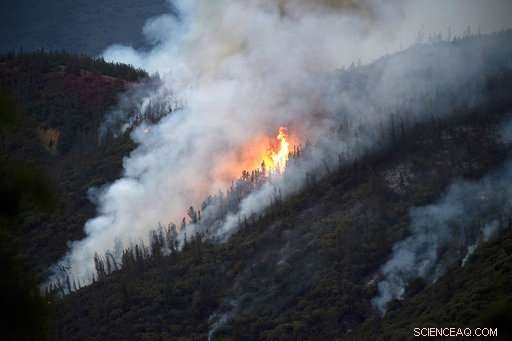
En este domingo 15 de julio, 2018, foto de archivo, las llamas del incendio de Ferguson se queman en la ladera de una colina en el condado no incorporado de Mariposa, California, cerca del Parque Nacional Yosemite. Los incendios forestales en los EE. UU. Han carbonizado a más de 10, 000 millas cuadradas en lo que va de año, un área más grande que el estado de Maryland, con grandes incendios todavía ardiendo en todos los estados occidentales, incluidos muchos que no están completamente contenidos. Caliente, los vientos secos pueden convertir las llamas en tormentas de fuego que dejan atrás tierras baldías carbonizadas propensas a la erosión y deslizamientos de tierra. (Foto AP / Noah Berger, Expediente)
El intervalo de tiempo entre incendios forestales en algunos lugares se está acortando, incluso cuando hay menos humedad para ayudar a que los árboles vuelvan a crecer. Eso significa que algunos bosques se queman entonces nunca volverás a crecer, convirtiéndose en cambio en tierra arbustiva más adaptada a los incendios frecuentes, dijo Jonathan Thompson, ecologista senior en la Universidad de Harvard.
"Se quedan atrapados en esta trampa de repetidos, fuego de alta severidad, ", Dijo Thompson." Con el tiempo veremos que la tierra de arbustos de California se desplaza hacia el norte ".
Se están observando cambios similares en Colorado, El Parque Nacional Yellowstone de Wyoming y el Parque Nacional Glacier en Montana, él dijo.
La relación entre el clima y el fuego es bidireccional. Una temporada de incendios más larga y mayores incendios en los bosques boreales de Alaska y Canadá están quemando no solo árboles, sino también tundra y materia orgánica en los suelos. que contienen aproximadamente un tercio del carbono terrestre de la Tierra, dijo David Peterson, ex científico investigador del Servicio Forestal de los EE. UU.
The carbon enters the atmosphere and contributes to higher temperatures, leading to bigger fires that release yet more carbon.
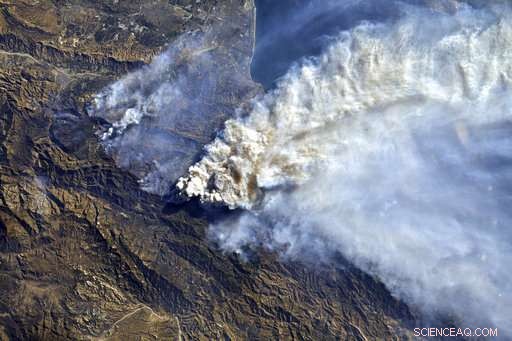
This Dec. 7, 2017 photo by NASA astronaut Randy Bresnik from the International Space Station shows smoke from California wildfires. Wildfires in the U.S. have charred more than 10, 000 square miles so far this year, an area larger than the state of Maryland, with large fires still burning in every Western state including many that are not fully contained. Whether sparked by lightning or humans, fire has long been a force shaping the landscape of the U.S. West. (Randy Bresnik/NASA via AP)
BIRD IN THE BALANCE
Life and property still top the list of priorities for firefighters, but in recent years another asset has been deemed worth extra protection in many Western states:a chicken-sized bird known as the greater sage grouse.
Fires burned an estimated 3, 240 square miles (8, 390 square kilometers) of the bird's sage bush habitat in 2017 and have burned almost 2, 400 square miles (6, 215 square kilometers) so far in 2018.
When sage brush burns, it's often replaced with a plant from Europe called cheatgrass, which crowds out native plants and is more prone to burning.
That's challenging government efforts to keep greater sage grouse off the endangered species list, which could restrict economic development.
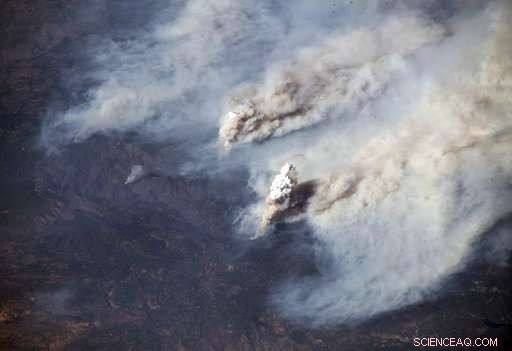
This Aug. 3, 2018, photo by European Space Agency astronaut Alexander Gerst aboard the International Space Station, provided by NASA, shows smoke from California's Carr and Ferguson fires blowing eastward across the western United States. Wildfires in the U.S. have charred more than 10, 000 square miles so far this year, an area larger than the state of Maryland, with large fires still burning in every Western state including many that are not fully contained. Whether sparked by lightning or humans, fire has long been a force shaping the landscape of the U.S. West. (Alexander Gerst/ESA/NASA via AP)
Areas considered crucial to the bird's survival now get extra attention:A military-type Blackhawk helicopter is under government contract to deploy quick-reaction teams to snuff out sage brush fires in portions of Idaho, Nevada, Utah and Oregon.
REGENERACIÓN
A turning point in public understanding of the ecological importance of fire came in 1988 , when 1, 240 square miles (3, 200 square kilometers) of Yellowstone National Park burned.
The devastation, punctuated by images of wildlife fleeing flames, fed into the perception of wildfires as a menace to be battled.
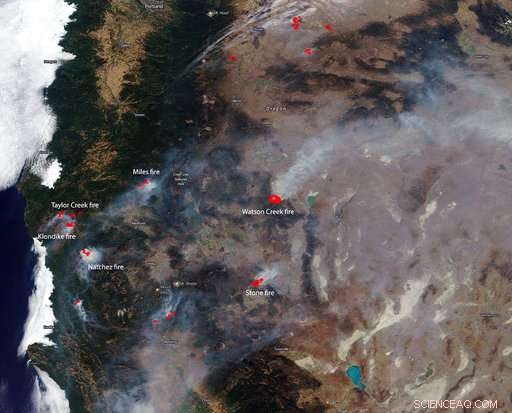
This NASA satellite image posted Aug. 20, 2018 shows several of the larger wildfires in both Oregon, cima, y California. Wildfires in the U.S. have charred more than 10, 000 square miles so far this year, an area larger than the state of Maryland, with large fires still burning in every Western state including many that are not fully contained. Whether sparked by lightning or humans, fire has long been a force shaping the landscape of the U.S. West. (NASA vía AP)
The events drew criticism of the park's "let it burn" policy. Officials didn't immediately squelch lightning-caused fires that June because they did not pose an immediate threat to life or property, but eventually ended up deploying 10, 000 firefighters.
By that fall, seedlings already were emerging in some burned out areas. Park biologist Roy Renkin recalls a visitor reacting with surprise a decade later when he told her a thick stand of young trees emerging from a burned area had come back on their own.
Lodgepole pines are commonly cited as an example of forest resiliency. The fire's heat releases seeds from the pine's cones.
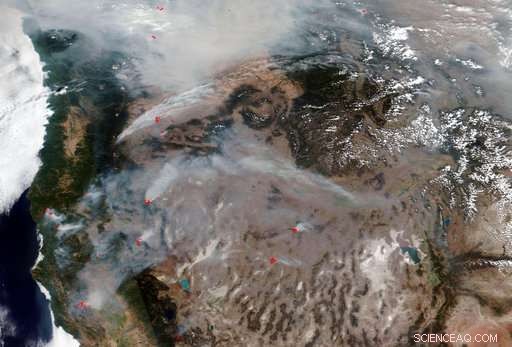
This image posted by the National Oceanic and Atmospheric Administration (NOAA), released by NASA, on Aug. 20, 2018, shows Western states, California at left, shrouded in smoke from the more than 100 large fires, including smaller fires within each complex of fires, that have erupted across the region during this fire season. Wildfires in the U.S. have charred more than 10, 000 square miles so far this year, an area larger than the state of Maryland, with large fires still burning in every Western state including many that are not fully contained. Whether sparked by lightning or humans, fire has long been a force shaping the landscape of the U.S. West. (NOAA vía AP)
Several species of woodpeckers thrive on insects attracted to fire-killed trees. A plant called fireweed is specially adapted to take root in fire-damaged soils, multiplying rapidly and forming carpets of pink petals against a blackened backdrop.
"It's isn't all death and destruction, " Renkin said. "These forests have evolved with fire."
© 2018 The Associated Press. Reservados todos los derechos.